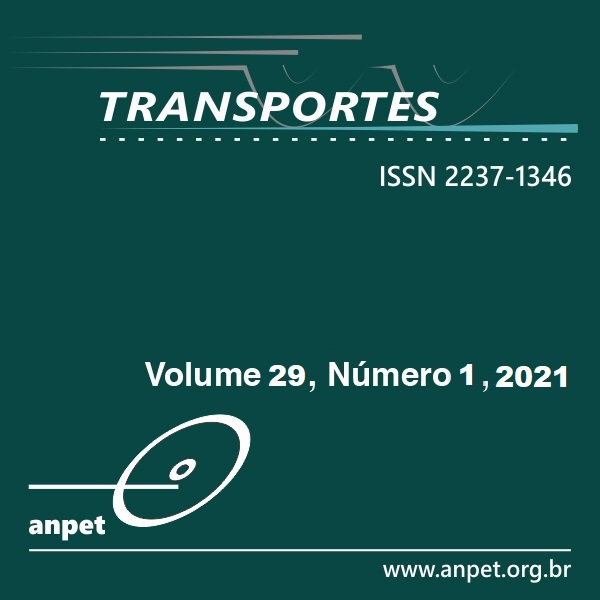Calibração da relação fundamental do tráfego a partir de bases de dados muito grandes
DOI:
https://doi.org/10.14295/transportes.v29i1.2317Palavras-chave:
Modelos de correntes de tráfego, Bases de dados muito grandes, Ajuste de modelos, Algoritmo genéticoResumo
Neste artigo, descreve-se um procedimento para ajustar modelos de correntes de tráfego a partir de bases de dados muito grandes. O procedimento proposto consiste em quatro etapas: (1) um tratamento inicial nos dados para eliminar observações espúrias (ruído) e homogeneizar a informação ao longo de toda a gama de densidades observada; (2) um ajuste inicial do modelo, baseado na soma dos erros quadráticos ortogonais; (3) uma segunda filtragem de dados, visando eliminar os outliers que sobreviveram ao tratamento inicial para eliminação do ruído; e (4) um segundo ajuste final do modelo. O método proposto foi testado ajustando-se o modelo de correntes de tráfego de Van Aerde a um conjunto de 104 mil observações coletadas por uma estação permanente de monitoramento de tráfego instalada numa autoestrada na região metropolitana de São Paulo. A calibração do modelo usou um algoritmo genético para procurar os melhores valores dos parâmetros do modelo. Os resultados obtidos demonstram a eficiência do método proposto.
Downloads
Referências
Arabas, J., Z. Michalewicz, & J. Mulawka (1994). GAVaPS-a genetic algorithm with varying population size. In Proc. of the 1st IEEE Conference on Evolutionary Computation. IEEE World Congress on Computational Intelligence, p. 73–78. IEEE. DOI: 10.1109/icec.1994.350039
Balakrishna, R., C. Antoniou, M. Ben-Akiva, H. N. Koutsopoulos, & Y. Wen (2007) Calibration of Microscopic Traffic Simulation Models: Methods and Application. Transportation Research Record: Journal of Transportation Research Board, v. 1999, p. 198–207, DOI: 10.3141/1999-21
Cardoso, J. M., L. Assirati, & J. R. Setti (2019). Influência das condições meteorológicas na operação de rodovias de pista dupla paulistas. In Anais do XXXIII Congresso Nacional de Pesquisa em Transportes, Balneário Camboriú. ANPET.
Chambers, L. D. (2000). The Practical Handbook of Genetic Algorithms: Applications. Chapman and Hall/CRC. DOI: 10.1201/9781420035568
Coifman, B. (2014) Revisiting the empirical fundamental relationship, Transportation Research Part B: Methodological, v. 68, p. 173-184. DOI: 10.1016/j.trb.2014.06.005
Coley, D. A. (1999). An introduction to genetic algorithms for scientists and engineers. World Scientific Publishing Company. DOI: 10.1142/3904
Demarchi, S. H. (2003). Uma nova formulação para o modelo fluxo-velocidade-densidade de Van Aerde. In CNT/ANPET (Ed.), Transporte em Transformação – 7, p. 77–94. Brasilia, DF: LGE.
Dervisoglu, G., G. Gomes, J. Kwon, R. Horowitz, & P. Varaiya (2009). Automatic calibration of the fundamental diagram and empirical observations on capacity. Paper presented at the 88th Annual Meeting of the Transportation Research Board.
Diaz-Gomez, P. & D. Hougen (2007). Initial population for genetic algorithms: A metric approach. In Proc. of the 2007 Intl. Conference on Genetic and Evolutionary Methods, GEM 2007, Las Vegas, pp. 43–49.
Draper, N. & H. Smith (1980). Applied Regression Analysis (2nd. ed. ed.). New York: John Wiley & Sons. DOI: 10.2307/1267833
FGSV (2015). Handbuch für die Bemessung von Straßenverkehrsanlagen: HBS 2015 Forschungsgesellschaft für Straßen und verkehrswesen. Cologne: FGSV.
Goldberg, D. E. (1989). Genetic Algorithms in Search, Optimization and Machine Learning. Boston: Addison-Wesley Longman.
Hall, F., V. F. Hurdle, & J. H. Banks (1992). Synthesis of recent work on the nature of speed-flow and flow-occupancy (or densi-ty) relationships on freeways. Transportation Research Record: Journal of Transportation Research Board v. 1365, p. 12–18.
Henclewood, D., W. Suh, M. O. Rodgers, & M. Hunter (2013) Statistical calibration for data-driven microscopic simulation model. Presented at 92nd Annual Meeting of the Transportation Research Board, Washington, D.C., 2013.
Hourdakis, J., P. G. Michalopoulos, & J. Kottommannil (2003) A Practical Procedure for Calibrating Microscopic Traffic Simula-tion Models. Transportation Research Record: Journal of Transportation Research Board, v. 1852, p. 130–139, DOI: 10.3141/1852-17.
Jha, M., G. Gopalan, A. Garms, B. P. Mahanti, T. Toledo & M. E. Ben-Akiva (2004) Development and calibration of a large-scale microscopic traffic simulation model. Transportation Research Record: Journal of Transportation Research Board, v. 1876, p. 121–131, DOI: 10.3141/1876-13
Karim, A. & H. Adeli (2002). Comparison of fuzzy-wavelet radial basis function neural network freeway incident detection model with California algorithm. Journal of Transportation Engineering, v. 128, n. 1, p. 21–30. DOI: 10.1061/(asce)0733-947x(2002)128:1(21)
Kerner, B. S. (2004). The Physics of Traffic – Empirical Freeway Pattern Features, Engineering Applications, and Theory. Berlin Heidelberg: Springer.
Knoop, V. L. & W. Daamen (2017). Automatic fitting procedure for the fundamental diagram. Transportmetrica B: Transport Dynamics, v. 5, n. 2, p. 129–144. DOI: 10.1080/21680566.2016. 1256239.
Knoop, V; S. P. Hoogendoorn & H. Van Zuylen (2009) Empirical differences between time mean speed and space mean speed. In: Traffic and Granular Flow ’07. Springer: Berlin, Heidelberg, p. 351–356, DOI: 10.1007/978-3-540-77074-9_36
Lee, J.-B. & K. Ozbay (2009) New calibration methodology for microscopic traffic simulation using enhanced simultaneous perturbation stochastic approximation approach. Transportation Research Record: Journal of the Transportation Research Board, v. 2124, p. 233–240, DOI: 10.3141/2124-23
Lu, S., Y. Jun, H. Mahmassani, G. Wenjun, & K. Bum-Jin (2010). Data mining-based adaptive regression for developing equilib-rium speed-density relationships. Canadian Journal of Civil Engineering, v. 37, n. 3, p. 389–400. DOI: 10.1139/L09-158
Ma, T., and B. Abdulhai (2002) Genetic Algorithm-Based Optimization Approach and Generic Tool for Calibrating Traffic Mi-croscopic Simulation Parameters. Transportation Research Record: Journal of Transportation Research Board, v. 1800, p. 6–15.
May, A. D. (1990). Traffic Flow Fundamentals. Upper Saddle River, NJ, USA: Prentice Hall.
Ni, D. (2016) Traffic Flow Theory: Characteristics, Experimental Methods, and Numerical Techniques. Oxford: Butterworth-Heinemann, p. 51–71. DOI: 10.1016/B978-0-12-804134-5.00004-0
Punzo, V., & M. Montanino (2016) Speed or spacing? Cumulative variables, and convolution of model errors and time in traffic flow models validation and calibration. Transportation Research Part B: Methodological, v.91, p. 21–33, DOI: 10.1016/j.trb.2016.04.012
Qin, X., & H. S. Mahmassani (2004) Adaptive calibration of dynamic speed-density relations for online network traffic estima-tion and prediction applications. Transportation Research Record: Journal of Transportation Research Board, v.1876, p. 82–89, DOI: 10.3141/1876-09
Qu, X., S. Wang, & J. Zhang (2015). On the fundamental diagram for freeway traffic: a novel calibration approach for single-regime models. Transportation Research Part B: Methodological, v. 73, p. 91–102. DOI: 10.1016/j.trb.2015.01.001
Rakha, H. (2009). Validation of Van Aerde’s simplified steadystate car-following and traffic stream model. Transportation Letters, v. 1, n. 3, p. 227–244. DOI:10.3328/TL.2009.01.03.227-244.
Rakha, H. & M. Arafeh (2010). Calibrating steady-state traffic stream and car-following models using loop detector data. Transportation Science, v. 44, n. 2, p. 151–168. DOI: 10.1287/trsc.1090.0297
Rakha, H. & B. Crowther (2003). Comparison and calibration of FRESIM and INTEGRATION steady-state car-following behav-ior. Transportation Research Part A: Policy and Practice, v. 37, n. 1, p. 1–27. DOI: 10.1016/s0965-8564(02)00003-4
Reeves, C. (1993) Using Genetic Algorithms with Small Populations. In: Proceedings of the Fifth International Conference on Genetic Algorithms (ICGA93), p. 92–99.
Sivanandam, S. N. & S. N. Deepa (2007). Introduction to Genetic Algorithms. Berlin: Springer. DOI: 10.1007/ 978-3-540-73190-0
Srinivas, M. & L. M. Patnaik (1994). Adaptive probabilities of crossover and mutation in genetic algorithms. IEEE Transactions on Systems, Man, and Cybernetics, v. 24, n. 4, p. 656–667. DOI: 10.1109/21.286385
Storn, R. (1996). On the usage of differential evolution for function optimization. In Proceedings of North American Fuzzy Information Processing, p. 519–523. IEEE. DOI: 10.1109/nafips.1996.534789
Toledo, T., M. E. Ben-Akiva, D. Darda, M. Jha, & H. N. Koutsopoulos (2004) Calibration of Microscopic Traffic Simulation Models with Aggregate Data. Transportation Research Record: Journal of Transportation Research Board, v.1876, p. 10–19, DOI: 10.3141/1876-02.
Van Aerde, M. (1995). Single regime speed-flow-density relationship for congested and uncongested highways. Paper pre-sented at the 74th Annual Meeting of the Transportation Research Board, Washington, D.C. Paper No. 950802.
Van Aerde, M. & H. Rakha (1995). Multivariate calibration of single regime speed-flow-density relationships. In Pacific Rim TransTech Conference. 1995 Vehicle Navigation and Information Systems Conference Proceedings. 6th International VNIS, p. 334–341. IEEE. DOI: 10.1109/vnis.1995.518858
Wang, H., Jia Li, Qian-Yong Chen & Daiheng Ni (2011). Logistic modeling of the equilibrium speed–density relationship, Transportation Research Part A: Policy and Practice, v. 45, n. 6, p. 554–566. DOI: 10.1016 /j.tra.2011.03.010
Wu, N. (2002). A new approach for modeling of Fundamental Diagrams, Transportation Research Part A: Policy and Practice, v. 36, n. 10, p. 867–884. DOI: 10.1016/S0965-8564(01)00043-X.
Yang, H. & K. Ozbay (2011) Calibration of microsimulation models to account for safety and operation factors for traffic con-flict risk analysis. Presented at 3rd International Conference on Road Safety and Simulation, September 14–16, 2011, Indianapolis, Ind.
Zhang, M., J. Ma, S. P. Singh & L. Chu (2008) Developing calibration tools for microscopic traffic simulation Final Report Part III: Global calibration—O-D estimation, traffic signal enhancements, and a case study. UCB-ITS- PRR-2008-8. California PATH Research Report, June 2008.
Zhong, R., C. Chen, A. H. Chow, T. Pan, F. Yuan, & Z. He (2016). Automatic calibration of fundamental diagram for first-order macroscopic freeway traffic models. Journal of Advanced Transportation, v. 50, n. 3, p. 363–385. DOI: 10.1002/atr.1334
Downloads
Publicado
Como Citar
Edição
Seção
Licença
Copyright (c) 2021 Juliana Mitsuyama Cardoso, Lucas Assirati, José Reynaldo Setti

Este trabalho está licenciado sob uma licença Creative Commons Attribution 4.0 International License.
Ao submeter um manuscrito para publicação neste periódico, todos os seus autores concordam, antecipada e irrestritamente, com os seguintes termos:
- Os autores mantém os direitos autorais e concedem à Transportes o direito de primeira publicação do manuscrito, sem nenhum ônus financeiro, e abrem mão de qualquer outra remuneração pela sua publicação pela ANPET.
- Ao ser publicado pela Transportes, o manuscrito fica automaticamente licenciado sob a Licença Creative Commons CC BY 4.0. Esta licença permite o seu compartilhamento com reconhecimento da autoria e da publicação inicial neste periódico.
- Os autores têm autorização para assumir contratos adicionais separadamente, para distribuição não exclusiva da versão do trabalho publicada neste periódico (por ex.: publicar em repositório institucional ou como capítulo de livro), com reconhecimento da publicação inicial na Transportes, desde que tal contrato não implique num endosso do conteúdo do manuscrito ou do novo veículo pela ANPET.
- Os autores têm permissão e são estimulados a publicar e distribuir seu manuscrito online (por ex.: em repositórios institucionais ou na sua página pessoal) depois de concluído o processo editorial. Como a Transportes é de acesso livre, os autores são estimulados a usar links para o DOI do artigo nesses casos.
- Os autores garantem ter obtido a devida autorização dos seus empregadores para a transferência dos direitos nos termos deste acordo, caso esses empregadores possuam algum direito autoral sobre o manuscrito. Além disso, os autores assumem toda e qualquer responsabilidade sobre possíveis infrações ao direito autoral desses empregadores, isentando a ANPET e a Transportes de toda e qualquer responsabilidade neste sentido.
- Os autores assumem toda responsabilidade sobre o conteúdo do manuscrito, incluindo as devidas e necessárias autorizações para divulgação de dados coletados e resultados obtidos, isentando a ANPET e a Transportes de toda e qualquer responsabilidade neste sentido.









